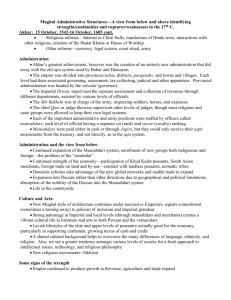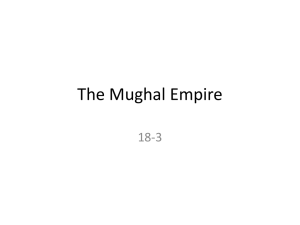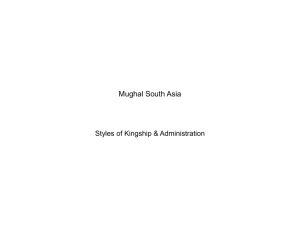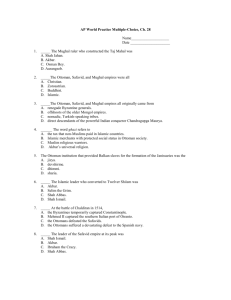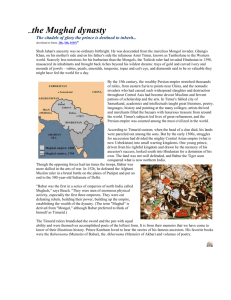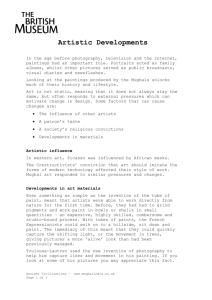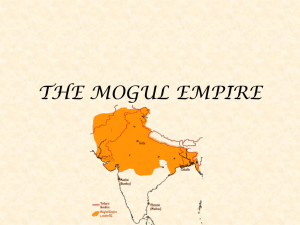The Mughal Empire
advertisement
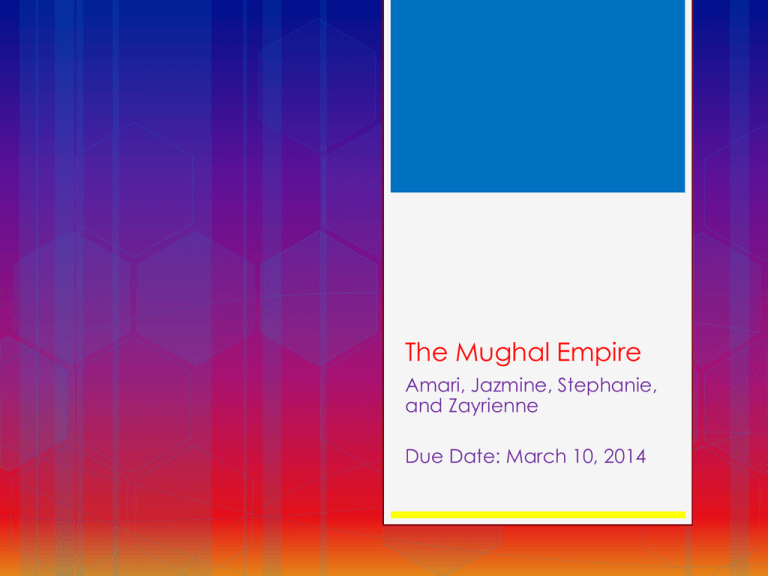
The Mughal Empire Amari, Jazmine, Stephanie, and Zayrienne Due Date: March 10, 2014 Rise The Delhi sultanate began to weaken in the early 1500’s and this left India open to invasion. The man who took advantage of this was a young Central Asian conqueror named Zahir ud-Din, but better known as Babur or “The Tiger”. After trying and failing to create an empire in Central Asia he turned to India. By 1526 he defeated the rulers and founded the Mughal Empire. The Mughals- whose name comes from the Persian word Mogul for “Mongol”- were India's first Muslim empire. Babur died shortly after his conquest and his grandson Akbar The Great took his place. Akbar The Great Geography Akbar expanded the sized of The Mughal Empire. Aurangzeb(one of Shah Jahan’s son) increased the empire to it’s largest size. Indian Ocean Hindu Kush and Himalayan Mountains. Indus River Arabian Sea and Bay of Bengal. Social Ruling class were Muslims. Emperor had all the power. Nobles had most of the important jobs. Zamindars had their own armed forces. Women were important to society. Men often sought their wives advice and some women fought alongside the men in wars. Political Ruled by an Emperor. Centralized government that brought smaller kingdoms together. Akbar married a nobleman’s daughter to gain their support. Aurangzeb issued strict decrees about morality and personal behavior and appointed officials to enforce them. He forbid Hindus and Sikhs high positions in government. When crowds of Shia and Sufi Muslims gathered to protest he ordered soldiers mounted on elephants to crush them. Religion Akbar was Muslim but he didn’t discriminate against other religions. There was no one religion and he was gracious in his support of all different religions. In 1581 Akbar created the Divine Faith which was a mix of his own ideas and those from debates. Jahangir(Akbar’s son) also practiced religious tolerance. He appointed both Hindu and Muslim officials. Shah Jahan(Jahangir’s son) did not practice religious tolerance. Aurangzeb was a strict Sunni Muslim who worked to impose his beliefs on society. He prosecuted Hindus and Sikhs and destroyed their temples. Intellectual Akbar was a patron of the arts and encouraged the development of science. He built a new capital called Fatehpur Sikri or the “City of Victory” to mark his achievements as an Emperor. Jahangir supported the arts and adopted many Persian influences into Indian society. Shah Jahan promoted literature and arts. He built a new capital for India in Delhi. At the heart was a chamber that held the Peacock Thorne. Their language was Urdu- Persian language mixed with Arabic and Hindu. Technology Created a road system and uniform currency. Architecture Humayun’s Tomb Economy During Akbar’s rule trade was developed. Shah Jahan imposed heavy taxes on the people to pay for monuments. He also launched wars against India’s neighbors in this need for money. Aurangzeb taxed Hindus and Sikhs. Used Mansabdar system to generate land revenue. Decline Aurangzeb’s strict rule caused frequent rebellions to break out. When he died rival claims to the throne led to civil war and invaders came in from the north. The Mughals continued to rule for about 150 more years, but held little power and less territory. In time, India fell under British rule. Lasting Legacies During Shah Jahan’s rule the Taj Mahal was built. Emperors Babur(born probably in Fergana[now Uzbekistan] on Feb. 15, 1483died Dec. 26, 1530 in Agra[now India])- Born Zahir ud-Din, descended from the Turkic conqueror Timur on his father’s side and from Chagatai, second son of Mongol ruler Genghis Khan, on his mother’s side. Humayun(born in Kabul[Afghanistan] on Mar. 6, 1508- died January 1556 in Delhi[India])- Son of Babur also called Nasin al-Din Muhammad. Akbar(born on Oct. 15, 1542 in Umarkot, Sindh[India]- died 1605 in Agra)- Son of Humayun. Full name Abu al-Fath Jalal al-Din Muhammad Akbar. Jahangir(born in Fatehpur Sikri on Aug. 31, 1569- died on Oct. 28, 1627 in route to Lahore[now in Pakistan])- Born Prince Salim. Son of Akbar. Married a Persian women. Shah Jahan(born on Jan. 5, 1592 in Lahore- died Jan. 22, 1666 in Agra)- Third son of Jahangir. Known as Prince Khurram until 1628. Aurangzeb(born on Nov. 3,1618 in Dhod, Malwa[India]- died Mar. 3, 1707)- Originally named Muhi al-Din Muhammad. Third son of Shah Jahan. Current Event March 16th, 2014 India [on Sunday] put on hold its search for missing Malaysia Airlines flight MH370, at the request of the government in Kuala Lumpur, which wants to reassess the week-old hunt for the Boeing 777 that is suspected of being deliberately flown off course. India had been combing two areas, one around the Andaman and Nicobar Islands, and a second, further west, in the Bay of Bengal. The fate of the flight, with 239 passengers and crew aboard, has been shrouded in mystery since it vanished off Malaysia's east coast less than an hour into a March 8 flight from Kuala Lumpur to Beijing. Malaysian Prime Minister, Najib Razak, said on Saturday the plane appeared to have been deliberately steered off course after someone on board shut down its communications systems. Questions 1. How was Muslim rule first established in India? Muslim raiders invaded and conquered the region of Sind in what is now Pakistan. About 300 years later, Muslims poured into north India from Afghanistan. By the 1200s, most of northern India was under Muslim Control. 2. What was the new empire created by Babur and Akbar like? The empire was one of the greatest civilizations in history. It was known for its wealth and power as well as its practice of religious tolerance. 3. What achievements were made by the rulers who held power at the height of The Mughal Empire? Art and trading which became a large part of the culture. The diffusion of Persian culture into their own and also the building of The Taj Mahal and new capitol in Delhi.

